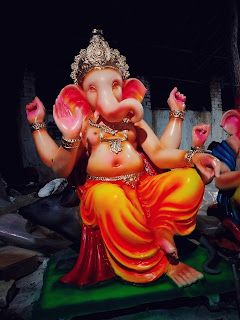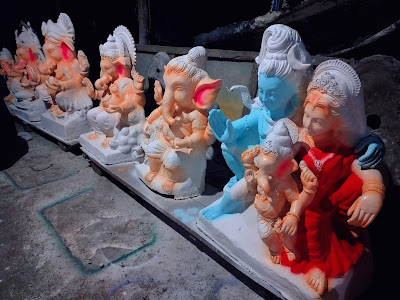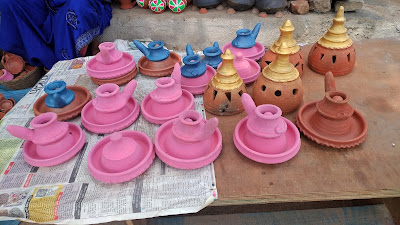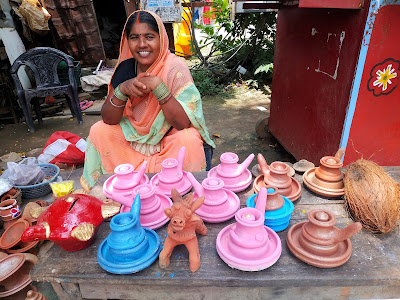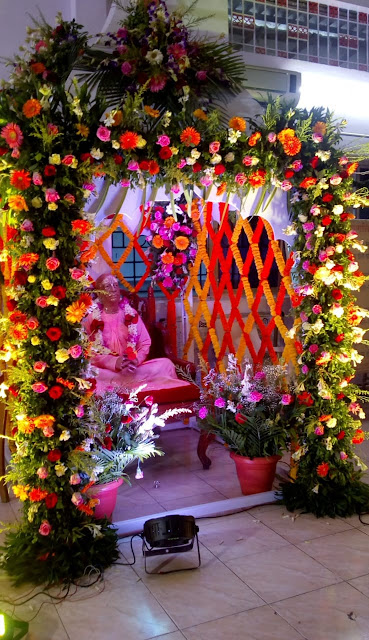Today is Anant Chaturdashi and Ganesh Visarjan and it's time to bid adieu to Vignaharta Shri Ganesh. So say a loud with me.....
गणपति बप्पा मोरया, अगले बरस तू जल्दी आ.... 🌺🙏🏼❤️
Lord Ganesha, the Elephant God, is not only the Lord of Beginnings and Remover of Obstacles, but also a teacher if you pay close attention to the tales of Hindu mythology. Also known as Ekdant, his anecdotes form an integral part of Hindu mythology and impart great life lessons to his followers. We can all learn a thing or two about life from these tales. So, let's bid our goodbye to bappa for this year and learn something from him to implement in our lives. Also, don't forget to know where he resides inside us in his cosmic form other than our hearts....
A good listener is as effective as a good talker.
With two large ears, Ganesha exemplifies this message. When people share their grief and sorrow with Ganesha, what they actually have is two-way communication, where Ganesha is playing the role of an active listener.
Most of the time what people really seek is a person whom they can talk to, a person who will listen without being judgemental. It is not important for a listener to shell out opinions or advice, you simply have to let them pour their hearts out.
A good listener always has a better understanding of the situation at hand. In decision-making, listening to others helps you analyse the situation from a different perspective and hence, guides you to a better solution.
So the next time someone walks up to you to communicate something, remember that listening is a crucial part of the process.
Forgiveness is the ultimate virtue
The legend says that Lord Ganesha once cursed the moon for mocking his pot-belly after he was returning from a satiating dinner party thrown by the Lord of Fortune, Kuber. The lover of food and desserts, Lord Ganesha was returning home after having a hearty meal, when he stumbled and rolled over on his belly. The Moon saw it from high above, and burst into a cynical laughter that miffed Lord Ganesha, and compelled him to curse him. Lord Ganesha cursed the moon to disappear from the sky completely, while he begged for forgiveness. Ultimately, the generous Lord Ganesha gave in to his requests, but since he couldn't revoke the curse, he reduced the disappearance span of the moon from the sky to one day.
Lord Ganesha's story explains how anger gets to the best of us, but it is our power to overcome it that makes us a better human being.
Always stand up for your self-respect
Legend has it that once, all the gods and goddesses left Lord Ganesha in-charge of the Swarg lok, as they left with Lord Vishnu's marriage procession headed towards Goddess Laxmi's abode. Lord Ganesha was tricked into taking care of Swarg lok, because the other deities were embarrassed of his physical appearance and massive diet. On getting to know the truth, Lord Ganesha wanted to avenge himself, and devised a clever plan that would make them realise his importance. Ganesha sent his rat-vehicle, Gajasur, to dig up the roads that led to Goddess Laxmi's abode, and he obeyed. As expected, the deities couldn't proceed further, and called for help. A farmer who was crossing by the road decided to help the deities, and pulled out the carriage stuck in the road in the first attempt after chanting Lord Ganesha's name. He explained how only Lord Ganesha's name could have induced the strength in him to lift the carriage, since he is the Remover of Obstacles. This made the deities realise that there's more to a being than his physical appearance, and they returned to offer their apologies to Lord Ganesha.
Lord Ganesha's story is a lesson to never let anyone undermine your abilities, or your physical appearance cloud people's judgement of you.
You should finish every task you take up
The legend says that sage Vyasa (Ved Vyasa) wanted to write the epic, Mahabharata, and he requested Lord Ganesha to write it down while he narrated the verse. The Lord agreed on one condition--Sage Vyasa was supposed to finish reciting the verses without a pause, and Lord Ganesha would write without taking a break. The two sat down to write one of the greatest epics known to mankind which contains 1.8 million words, but faith had something else in store--Lord Ganesha's pen broke while he was still writing. Lord Ganesha broke one of his tusks, and continued writing the epic.
Lord Ganesha sacrificed his own tusk to finish a task meant for greater good. If we could all imbibe this lesson from him, we'd all be closer to success than we already are.
Lord Ganesha is one of the celestial deities holding the divine prominence in Vedic scriptures. His form, intellect, divinity and strengths are glorified in the Ganesh Purana. He is the ruling deity of the Muladhara Chakra and blesses his devotees with wisdom and ability to face challenges and obstacles in life. He has a pot belly signifying contentment and fullness. He holds a fragrant Modak in His left hand signifying the bliss of satisfaction that he provides. His vehicle, the Mouse, signifies that one needs to curb wishes (signified by mouse) to achieve his state.
Puranas mention that Lord Ganesha is the god of letters, learning and wisdom. In Sanskrit, the word buddhi is a feminine noun that is variously translated as intelligence, wisdom, or intellect. The Ganesh Purana and Ganesh Sahasranama (thousand names of Ganesha) mention one of the names as Buddhipriya, the one who is fond of intelligence. Buddhi (sense or intellect) is a female word meaning Lord Ganesha is the husband (priya or lover) of Buddhi.
As per Kundalini Yoga, the human body receives its subtle cosmic energies from seven chakras that are ruled by different gods. Every chakra has an emotional significance and a physical or biological significance, which is related with our hormonal system. The root chakra is the first of the chakras of matter. Balancing the root chakra creates the solid foundation for opening the chakras above.The root chakra is comprised of whatever grounds you to stability in your life. This includes your basic needs such as food, water, shelter, and safety, as well as your more emotional needs such as letting go of fear. When these needs are met, you feel grounded and safe, and you tend to worry less day to day. Biologically, it is associated with reproductive glands i.e. testes in men; ovaries in women, which controls reproductive development and secretes reproductive hormones.
The energy resides in the Root or Muladhara Chakra, which is dormant & the main purpose of life, as we know it, is to make this Energy or Shakti or Kundalini, rise, go through each Chakra & then reside in the Crown Chakra. Lord Ganesha rules Muladhara Chakra, the Root Chakra associated with family, stability and knowledge. Mula means ‘main, root or original’ and adhara means ‘base or foundation’, meaning the Lord Ganesha is the root cause of our familial happiness and domestic peace that are absent without his blessings. The Ganapati Atharvashirsa mentions a verse: “O Ganesha! You reside at the base of the spine”.
In the Kundalini Yoga sutras, Lord Ganesha mentioned as the ruler of Root Chakra (Muladhara Chakra) connected with the foundation or stability in your life. Also in Ganapati Atharvashirsa it is given that "Lord Ganesha continually dwells in the sacral plexus at the base of the spine, Mūlādhāra Chakra. He resides permanently in every living being at the Muladhara. He guides all other chakras, thereby leading the forces that propel the wheel of life”. Therefore, Lord Ganeha is the primal force that supports the foundation of every aspect of your life. He removes all the obstacles to all your undertakings. One should meditate on him every day in the morning.
Captured and edited by : Kamya
As no spiritual growth can take place without chopping of the head of false ego & directing the Consciousness upwards towards The Mother Energy, the most auspicious of all things in Creation, that is why, for every auspicious beginning we pray to Lord Ganesha. It is only via Him, that all good can take place & take place calmly. Energy needs to be first & foremost pure & that pure Energy needs to be channelled upwards. But Energy in its Original Form is neither pure or impure, it is just energy.
Curated by : Kamya
I hope you learnt something from this blog on Ganapati Bappa and enjoyed it as much as I did. Even I have learnt very much about chakras while researching for this blog, and therefore it is one of my favourite and informative blog ever. So, if you learnt anything or loved any shot or my new editing style from this blog, or want more spiritual blogs like this, do let me know in the comments section below and do share this blog with the world. And for more content like this, Stay tuned to your favourite blog.....
See you in the next blog soon, till then,
Have a wonderful day, take care and....
always remember to love yourself first!! ❤
May this pandemic end from this world till Bappa arrives the next year. And may Bappa shower you with lots of good luck, fortune, health, happiness, prosperity and his blessings the whole year. ✨🌺🙏🏼
गणपति बप्पा मोरया, पुढच्या वर्षी लवकर या ✨🙏🏼❤️🌺


























